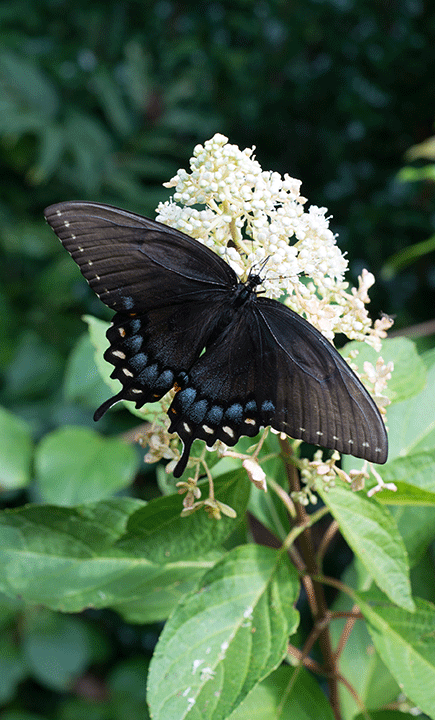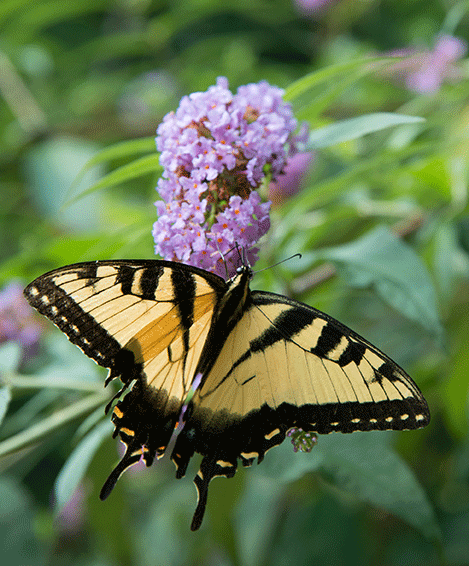
Black Swallowtail. Photos by L.A. Jackson
By L. A. Jackson
Spring is an ideal time for gardeners who love ornamental plants to plan for not only a bountiful show of blooms but also butterflies. That’s right–butterflies.
These bright flits of kinetic color are enough to make even the most distracted backyard grower take notice. Of course, stray butterflies will fly into the garden just about any time during the spring and summer months, but when it comes to finding these beautiful winged insects in the landscape, the more the merrier! And the best way to bring in more butterflies is to simply offer them something to eat.
This can be done by serving up plants off of butterflies’ Most Preferred List, which is actually two lists because mature butterflies go for flowering, nectar-producing plants, while their young–caterpillars–prefer to munch on plant foliage. Some butterflies are pretty finicky eaters, but in general, there are plenty of plants around that will attract a large assortment of these beauties.
Nectar-loving adults are, of course, drawn to blooming plants. They seem to favor plants with red flowers first, followed then by yellows, pinks, whites and purples. Also, they like blossoms that are flat-topped or clustered to allow them to land so they can feed while in park. Call it a fly-in diner, if you will.
And what specific kinds of flowers can be classified as butterfly magnets? Spring bloomers such as primrose, money plant, lilac, sweet William, rock cress and candytuft are great for attracting an assorted variety of adult butterflies at the beginning of the growing season.
In the summer, butterfly weed, bee balm, purple coneflower, butterfly bush, cosmos, daylilies, lantana, periwinkle, scabiosa, lavender, hydrangeas, yarrow, zinnias, phlox and verbena are some good choices to take over from the spring flowers and continue bringing butterflies into your garden.
Butterflies will flock to fall flowers as well. Sedums, asters, salvias and swamp sunflower are a few of the better late-blooming butterfly baits.
The blossoms of many native trees also double as desirable food for adult butterflies. Examples include tulip poplar, wild cherry, sassafras, persimmon, hackberry, redbud and pawpaw.

butterfly bush blossom.
Even weeds will draw these winged beauties into your yard. Clover, henbit, morning glory and dandelion are all native “volunteer” plants that pop up in the landscape and serve as sources for nectar.
The difference between a “weed” and a “native plant” often lies in its desirability in the garden. Many native plants are simply too pretty to not be included in cultivated gardens, and as a bonus, their nectar also attracts adult butterflies. Such indigenous lovelies include liatris, black-eyed Susan, cardinal flower, coreopsis, Indian blanket, ironweed, goldenrod and Joe-pye weed.
Butterfly larvae also like weeds. And since they munch on the foliage of these plants that many gardeners find undesirable, the caterpillars are actually helping with landscape maintenance. Some caterpillars chew on certain tree leaves as well. Elm, river birch, poplar, willow, dogwood and cherry trees seem to be tops on many of their dining lists. But as long as these leaf-eaters keep damage to a minimum, it is easy to live with their presence.
Interestingly, some butterfly caterpillars tend to be plant-specific–in other words, very picky about what kind of greenery they eat. A good example is butterfly weed. While this native perennial’s nectar is a big favorite for many different adult butterflies, its foliage is especially sought out by Monarch larvae. This is also true for many of the other related plants in the Milkweed family.
As a similar example, Black Swallowtail caterpillars have a preference to feed on the native golden Alexander as well as related plants–and this sometimes gets them in trouble. Golden Alexander is from Parsley family, which also includes three other plants young Black Swallowtails prefer: the popular garden herbs parsley, fennel and dill. However, many concerned herbalists coexist with these larvae by either picking them off the plants and moving them to other greenery, or planting more parsley, fennel and dill than man or beast will ever consume in a summer.
And the Spicebush Swallowtail actually gets its name from the source of its larvae’s preferred food: the spicebush, which is a small native shrub often found on flood plains and along ditch banks.
A good way to attract more adult butterflies into a garden is to concentrate the right plants in large enough numbers so these fliers can easily see what you have to offer when they are flitting through the neighborhood. A clump or two of purple coneflowers won’t effectively do the job, but a massed bed or border filled with these plants in full bloom will be a big neon sign that, to butterflies, spells “F-O-O-D!”
Another trick for bringing in butterflies is to add shallow dishes of water, wet sand or mud in the garden. You will be surprised how many of these winged beauties will congregate around such watering holes! Since butterflies also like sweets, sugar, honey or pieces of fruit can be added to enhance this butterfly bar, but be forewarned that such treats will also catch the attention of ants, wasps and bees.
One more amenity that can appeal to these wonderful winged insects is large, flat rocks placed in an area that receives the morning sun. Butterflies are cold-blooded creatures and will seek out such toasty spots to warm themselves up at the start of a new day.
Of course, if you are committed to bringing in more butterflies to your garden this growing season, one other item you might think about picking up is a good book that identifies the different types of butterflies in your region. It can become a fascinating hobby, and, after all, you wouldn’t want to mistake an American Painted Lady for a Great Spangled Fritillary, would you?
Butterflies and Insecticides
Being insects, butterflies will not fare well in a garden that is heavily dependent on insecticides to keep bad bugs at bay. In particular, broad spectrum insecticides–commercial concoctions that usually list on their labels dozens and dozens of different bugs they kill–are especially dangerous for butterflies. Probably less known is the fact that systemic insecticides can be equally hazardous because they make all parts of the plants poisonous to insects, meaning they put both leaf-munching butterfly caterpillars and nectar-sipping adults at risk.
An easy way to deal with damaging bugs in a dedicated butterfly garden is to lessen the need for insect poisons by picking more plants that are insect-resistant. There are plenty of modern cultivars that have been developed to be less appealing to destructive insects, but for time-tested toughness, also consider native plants. By their evolved nature, most indigenous plants have survived and thrived in the wild against bad bugs, so including some of them in your landscape is another kinder, gentler step towards creating a butterfly-friendly garden.
L.A. Jackson has been a garden editor, lecturer and writer for over 20 years and has led many tours overseas through the great gardens of Europe. He lives in North Carolina.




